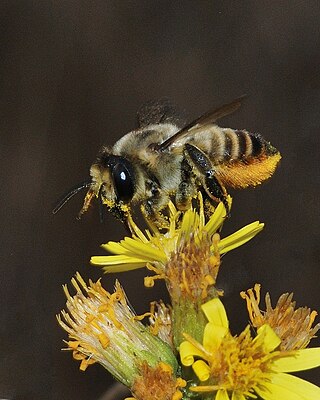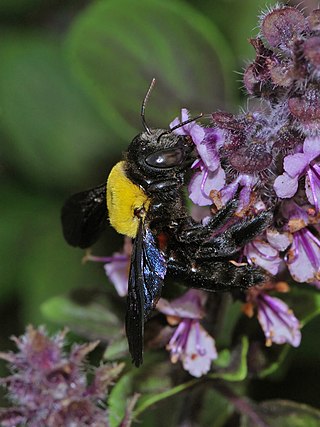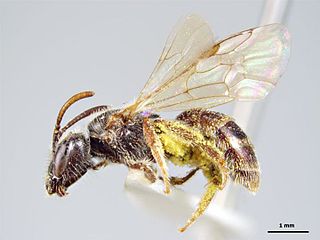
Megachile rotundata, the alfalfa leafcutting bee, is a European bee that has been introduced to various regions around the world. As a solitary bee species, it does not build colonies or store honey, but is a very efficient pollinator of alfalfa, carrots, other vegetables, and some fruits. Because of this, farmers often use M. rotundata as a pollination aid by distributing M. rotundata prepupae around their crops. Each female constructs and provisions her own nest, which is built in old trees or log tunnels. Being a leafcutter bee, these nests are lined with cut leaves. These bees feed on pollen and nectar and display sexual dimorphism. This species has been known to bite and sting, but it poses no overall danger unless it is threatened or harmed, and its sting has been described as half as painful as a honey bee's.

Megachilidae is a cosmopolitan family of mostly solitary bees. Characteristic traits of this family are the restriction of their pollen-carrying structure to the ventral surface of the abdomen, and their typically elongated labrum. Megachilid genera are most commonly known as mason bees and leafcutter bees, reflecting the materials from which they build their nest cells ; a few collect plant or animal hairs and fibers, and are called carder bees, while others use plant resins in nest construction and are correspondingly called resin bees. All species feed on nectar and pollen, but a few are kleptoparasites, feeding on pollen collected by other megachilid bees. Parasitic species do not possess scopae. The motion of Megachilidae in the reproductive structures of flowers is energetic and swimming-like; this agitation releases large amounts of pollen.

Mason bee is a name now commonly used for species of bees in the genus Osmia, of the family Megachilidae. Mason bees are named for their habit of using mud or other "masonry" products in constructing their nests, which are made in naturally occurring gaps such as between cracks in stones or other small dark cavities. When available, some species preferentially use hollow stems or holes in wood made by wood-boring insects.

Osmia lignaria, commonly known as the orchard mason bee or blue orchard bee, is a megachilid bee that makes nests in natural holes and reeds, creating individual cells for its brood that are separated by mud dividers. Unlike carpenter bees, it cannot drill holes in wood. O. lignaria is a common species used for early spring fruit bloom in the United States and Canada, though a number of other Osmia species are cultured for use in pollination.

Osmia cornifrons, also known as the horned-face bee, is a species of solitary bee indigenous to Northern Asia. Physically, this species of bee is recognized for its horn-like extensions originating from its lower face. Populations of O. cornifrons have been recorded in multiple locations, including Japan, Korea, China, and Russia. O. cornifrons are more docile as compared to other species of bees and are less prone to sting when aggravated.

The genus Megachile is a cosmopolitan group of solitary bees, often called leafcutter bees or leafcutting bees; it also includes the called resin bees and mortar bees. While other genera within the family Megachilidae may chew leaves or petals into fragments to build their nests, certain species within Megachile neatly cut pieces of leaves or petals, hence their common name. This is one of the largest genera of bees, with more than 1500 species in over 50 subgenera. The alfalfa leafcutter bee is managed on a commercial scale for crop pollination, and has been introduced by humans to various regions around the world.

Osmia californica is a megachilid bee, or mason bee. Native to North America, the mason bees are important pollinators, with O. california pollinating over 33 genera from 13 plant families. O. californica generally emerges a little later in the spring than the better known orchard mason bee. Like the orchard mason bee, O. californica is a solitary nester, usually constructing nests with leaf pulp providing a partition within the nest to protect the egg chamber.

Megachile sculpturalis, known as the giant resin bee and sculptured resin bee, is a species of leafcutting bees belonging to the family Megachilidae.

Osmia bicornis is a species of mason bee, and is known as the red mason bee due to its covering of dense gingery hair. It is a solitary bee that nests in holes or stems and is polylectic, meaning it forages pollen from various different flowering plants. These bees can be seen aggregating together and nests in preexisting hollows, choosing not to excavate their own. These bees are not aggressive; they will only sting if handled very roughly and are safe to be closely observed by children. Females only mate once, usually with closely related males. Further, females can determine the sex ratio of their offspring based on their body size, where larger females will invest more in diploid females eggs than small bees. These bees also have trichromatic colour vision and are important pollinators in agriculture.

A wasp is any insect of the narrow-waisted suborder Apocrita of the order Hymenoptera which is neither a bee nor an ant; this excludes the broad-waisted sawflies (Symphyta), which look somewhat like wasps, but are in a separate suborder. The wasps do not constitute a clade, a complete natural group with a single ancestor, as bees and ants are deeply nested within the wasps, having evolved from wasp ancestors. Wasps that are members of the clade Aculeata can sting their prey.

Andrena agilissima is a species of mining bee. They are present in most of Europe, the Near East and North Africa and can be found from April through July. Andrena agilissima is an oligolectic species, feeding only on the pollen of a few genera of Cruciferous vegetables.

Coelioxys, common name leaf-cutting cuckoo bees or sharp-tailed bees, is a genus of solitary kleptoparasitic cuckoo bees belonging to the family Megachilidae.

The Oriental carpenter bee, Xylocopa nasalis, or Xylocopa (Biluna) nasalis, is a species of carpenter bee. It is widely distributed in Southeast Asian countries. It is a major pollinator within its ecosystem, and is often mistaken for a bumblebee. The species leads a solitary lifestyle with a highly female-biased colony in the nest.

Xylocopa pubescens is a species of large carpenter bee. Females form nests by excavation with their mandibles, often in dead or soft wood. X. pubescens is commonly found in areas extending from India to Northeast and West Africa. It must reside in these warm climates because it requires a minimum ambient temperature of 18 °C (64 °F) in order to forage.

Macrotera portalis is a species of communal, ground nesting, partially bivoltine bees found in arid grasslands and desert regions of North America. An oligolectic bee, M. portalis gathers pollen only from plants in the genus Sphaeralcea and has patterns of seasonal emergence to survive the harsh conditions of the desert, with emergence delayed until monsoon rains arrive.
Chaetodactylus is a genus of parasitic mite primarily associated with solitary bees with over 20 species.

Chaetodactylus krombeini was described by Karl Krombein and E. W. Baker in the 1960s. The mites are about 0.5 mm across, with the females larger than the males. Pollen mites are a kleptoparasitic pest of Megachilid solitary bees, with Ch. krombeini found with Osmia lignaria of North America,. Pollen mites do not feed on bees, but rather their provisions, and are harmful because they consume the food resources and starve or stunt the developing larvae; there is evidence that pollen mites also directly harm the egg by puncturing it.

Lasioglossum mataroa is a bee species that is found in New Zealand.

Leioproctus boltoni is a species of bee in the family of plasterer bees. This species was first described in 1904 and is endemic to New Zealand. They are a solitary bee, small and black in appearance. L. boltoni can be found throughout the main islands of New Zealand and forages on the flowers of both native and introduced species of plants. This species nests in the soil with their life cycle lasting approximately a year.

Osmia nigriventris, also known as the large black-bellied mason bee, is a species of solitary bee within the family Megachilidae.


















